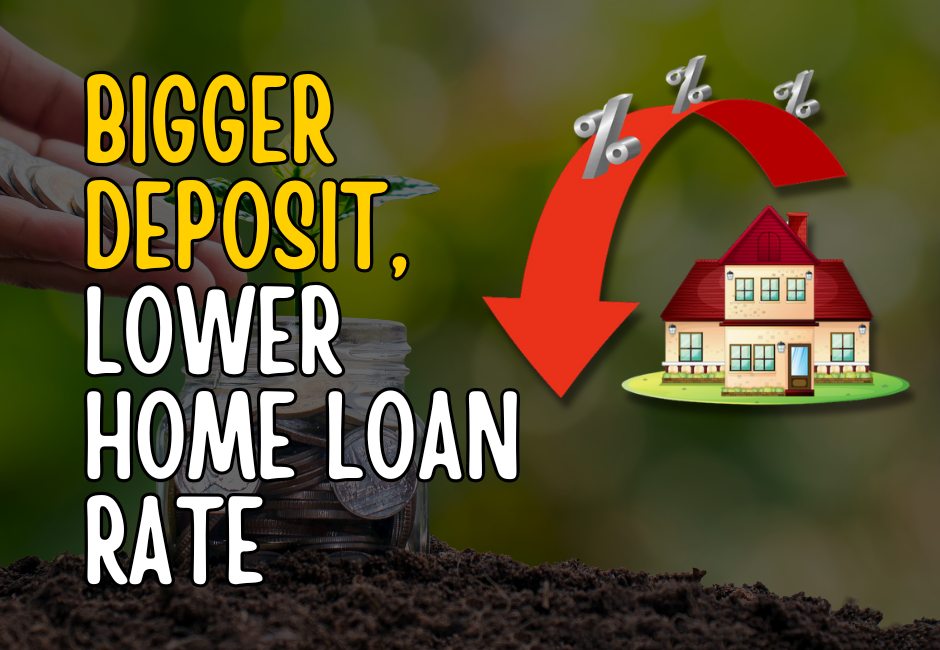
How Your Deposit Size Affects the Home Loan Interest Rate You Get
Understanding the Connection Between Deposit Size and Interest Rates
When applying for a home loan, many borrowers focus on credit scores, income, and lender options. But one of the most important factors influencing the interest rate you receive is your deposit size.
A larger deposit reduces the lender’s risk, which often leads to lower interest rates, better loan terms, and fewer fees. In contrast, a smaller deposit can result in higher rates, additional costs like Lenders Mortgage Insurance (LMI), and tighter borrowing conditions.
The key questions many borrowers ask: How much deposit do I need for a better rate? And should I wait to save more before applying for a mortgage?
This guide explains:
- How deposit size impacts interest rates
- The role of LMI and its cost implications
- Smart strategies to grow your deposit
- Whether it’s wiser to buy now or wait and save
By the end, you will have the insights you need to make informed, cost-effective mortgage decisions.
How Deposit Percentages Affect Mortgage Rates
Lenders use the Loan-to-Value Ratio (LVR) to assess risk. LVR is the portion of the property’s value you need to borrow. A larger deposit means a lower LVR, which generally secures you better interest rates.
| Deposit Size (% of Property Value) | LVR | Typical Interest Rate Range | LMI Required? |
| 5% | 95% | 6.5% – 7.5% | Yes; adds thousands |
| 10% | 90% | 6.0% – 7.0% | Yes; slightly lower LMI |
| 15% | 85% | 5.5% – 6.5% | Yes; smaller LMI cost |
| 20% | 80% | 5.0% – 6.0% | No LMI required |
| 30% | 70% | 4.5% – 5.5% | No LMI; best rates |
Key takeaways:
- Deposits under 20% typically come with higher rates and LMI.
- A 20% deposit helps avoid LMI and unlocks lower mortgage rates.
- Deposits over 30% often qualify borrowers for the most competitive rates.
The Role of Lenders Mortgage Insurance (LMI)
LMI is a hidden cost that applies when your deposit is less than 20%. It protects the lender — not you — if you default on the mortgage.
Example of LMI Costs by Deposit Size
| Property Value | Deposit Size | LVR | Estimated LMI Cost |
| $600,000 | 5% ($30,000) | 95% | $22,000 – $25,000 |
| $600,000 | 10% ($60,000) | 90% | $12,000 – $14,000 |
| $600,000 | 15% ($90,000) | 85% | $6,000 – $8,000 |
| $600,000 | 20% ($120,000) | 80% | $0 |
Impact of LMI on your mortgage:
- Increases total borrowing costs, sometimes by tens of thousands
- May lead to slightly higher interest rates due to higher risk
- Can often be rolled into the mortgage, increasing repayments
How to Save for a Larger Deposit and Secure Better Rates
Even if a 20% deposit feels out of reach, several smart strategies can help you save faster and improve your borrowing position.
- Set a Specific Savings Target
Use an online deposit calculator to determine how much you need, including LMI, stamp duty, and legal costs. - Use Government Schemes
Investigate programs like:- First Home Guarantee (buy with 5% deposit and no LMI)
- First Home Owner Grant (FHOG)
- Stamp duty discounts in certain states
- Open a High-Interest Savings Account or Use an Offset Account
Place savings in an account earning competitive interest or use an offset account linked to an existing loan. - Boost Savings with Extra Income or Reduced Expenses
Cut back on non-essential spending or take on part-time work, freelancing, or selling unused assets. - Consider a More Affordable First Purchase
Buying a smaller or lower-priced home can help you build equity and work your way up the property ladder.
Should You Buy Now or Wait to Save a Larger Deposit?
This is a common dilemma, and both options have pros and cons.
Buying now with a smaller deposit:
- Enter the market sooner, before prices potentially rise
- Begin building equity sooner
- Access government programs that reduce LMI or boost affordability
Potential downsides:
- Higher interest rates and borrowing costs
- LMI costs add to overall expenses
Waiting to save a larger deposit:
- Qualify for lower rates and better loan terms
- Avoid LMI, saving thousands
- Stronger financial position when applying
Potential downsides:
- Risk of property prices rising while you save
- Delayed entry into the property market
The right choice depends on your local market conditions, income stability, and long-term financial goals.
Making Smart, Data-Backed Mortgage Choices
Your deposit size has a direct impact on your interest rate, borrowing costs, and loan terms.
Key points to remember:
- Larger deposits mean lower rates and no LMI.
- Deposits under 20% often trigger LMI and higher costs.
- Saving an extra 5–10% can unlock thousands in savings over your loan’s life.
- Government schemes and smart savings strategies can help you enter the market sooner.
- Always compare rates, fees, and lender terms before making a decision.




